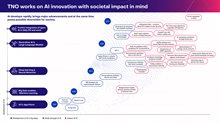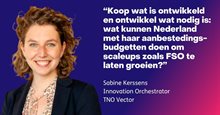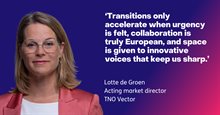The timeline of AI
In the 1950s and 1960s, AI and algorithms were a growing scientific discipline, but they still had little impact on the everyday lives of the general public.
Alan Turing, a pioneer of AI, published his seminal paper ‘Computing Machinery and Intelligence’ in 1950. He also introduced the Turing test to determine whether a computer’s intelligence was distinguishable from that of a human.
Gordon Moore predicted in 1965 that the performance of computer hardware would improve exponentially. This later became known as Moore’s Law.
In the 1970s and 1980s, AI development stagnated due to technological limitations and high research costs, a period known as the ‘AI winter’.
Around 2000, the rise of big data made machine learning possible, and AI evolved rapidly in line with Moore’s Law. Deep learning and neural networks marked a turning point with improvements in facial recognition, the rise of social media, and Industry 4.0. At the same time, data breaches led to concerns about personal data.
After 2020, generative AI (GenAI) and large language models increased in importance, becoming more widely deployed by governments, businesses, and citizens. This led to attention being given to the negative consequences of AI, such as bias, intellectual property infringement, and dependence on large technology companies. An urgent need for regulation and governance arose.
We are in an exciting phase in which GenAI is increasingly being used, which is generating many benefits, but also raising questions about how to safeguard public values such as autonomy, security, and justice.

This image shows some examples of AI’s development, technological breakthroughs, and the growing attention being given to its societal implications.
What is TNO Vector contributing?
At TNO Vector, social and exact scientists work together on societal transitions, such as the digital, energy, and raw materials transition. Due to its societal impact, understanding AI also requires knowledge of public administration, psychology, sociology, economics, and law.
In addition to technological innovation, there is a need for strategic thinking and innovation in AI-related governance, regulation, and policy.
TNO Vector researchers collaborate on several propositions within TNO. TNO Vector itself works in the impact area of value-based digital society to build knowledge and apply it in practice.
Here are some recent TNO Vector projects:
1. Enhancing Dutch and European digital sovereignty
The most significant AI breakthroughs are originating from the US, leaving us dependent on a few Big Tech companies. The Netherlands and Europe are therefore striving for greater digital sovereignty.
TNO contributes by developing technology, advising on policy and business models, and bringing public and private parties together for joint solutions.
In the report “Towards a sovereign digital future – the Netherlands in Europe”, we show how we contribute to digital sovereignty, by addressing, among other things, the role that RTOs like TNO will play this.
2. Comparative study on AI strategies in the Netherlands, Finland, and Sweden
European countries such as the Netherlands, Finland, and Sweden are at the forefront of AI development. This makes it interesting to see what AI strategy these countries have and what we can learn from each other.
For this study, TNO Vector collaborated with the Technical Research Centre of Finland (VTT) and the Research Institutes of Sweden (RISE). We identified six key dimensions along which AI strategies can be compared. We unravelled the differences and similarities, described how the strategies were arrived at, and discussed their expected and achieved results.
We conclude that there is no standard model for AI strategies, but that it is useful for countries to share experiences to maximise the potential of AI.
3. Study on AI legislation for European Parliament
The rapid proliferation of AI-based products and systems calls for regulation at European level. Commissioned by the European Parliament’s Panel for the Future of Science and Technology (STOA), TNO Vector conducted research on AI legislation prepared in the EU.
We examined the differences between public and private sector obligations in the use of certain AI systems. We focused on three applications of AI: biometrics, social scoring, and manipulative AI.
We identified risks, when systems should be allowed or prohibited, and what obligations arise from their use. The study provides comprehensive analysis and policy recommendations.
4. AI: In search of the human dimension
In the paper ‘AI: In search of the human dimension’, we analyse 15 commonly used standards frameworks. We found that these frameworks contain many different standards, but do not clarify who decides how they are applied.
In addition, many standards frameworks are not aimed at the users of the technology, but at the developers. These are often commercial parties that are only partially involved in the implementation of decisions.
Ultimately, the responsibility for the system often lies with the parties that use the AI systems in their automated decision-making. That is why these frequently used methodologies are generally better suited to an ex-post assessment of the impact of AI systems.
The paper’s main recommendation is that there should be experimental environments to incrementally test AI systems for algorithmic decision-making.
5. Quickscan on AI in public services
TNO Vector has conducted three studies on how the government is using AI. In 2019, a longlist of AI applications in public services was drawn up. The second exploration in 2021 looked at AI developments since 2019, the impact of AI applications, and the opportunities and challenges for government.
We found that AI was being increasingly used for societal issues and decision-making, such as understanding poverty or debt, detecting crime, and maintaining infrastructure.
Three case studies were developed. The third exploration in 2024 examines the changes since 2021. The results were published on 25 June 2024.
Conclusion
TNO Vector conducts research on the responsible development and deployment of AI and, together with stakeholders, develops useful frameworks and tools for AI governance.
In addition, we expect that themes such as the impact on the labour market, digital autonomy, and sustainability will become increasingly important in the coming years.
What is the impact of AI on labour demand and how will supply respond? How will we deal with the growing dependence on large, non-European tech companies? What are the opportunities to become more digitally autonomous? And what does the growing use of data-driven tools and AI mean for our footprint, and are there ways to influence this?
Would you like more information on the AI study? Visit the AI section of the TNO website.




